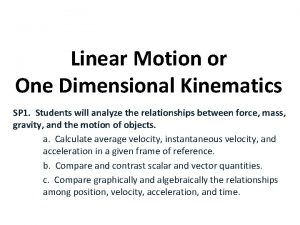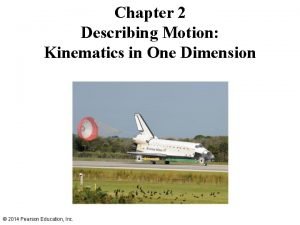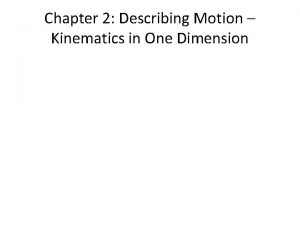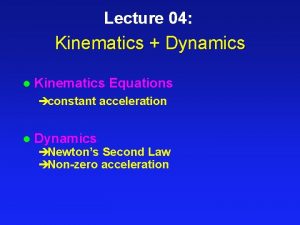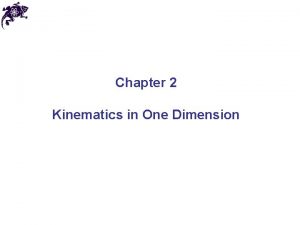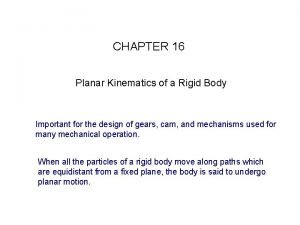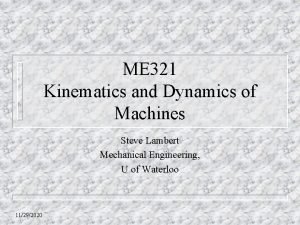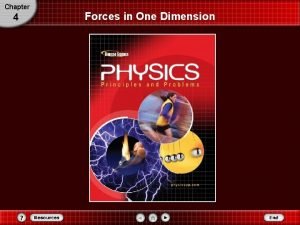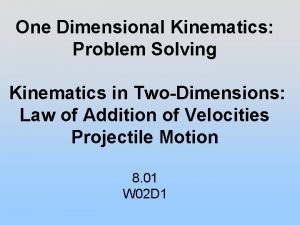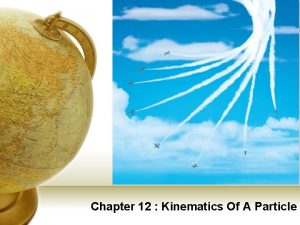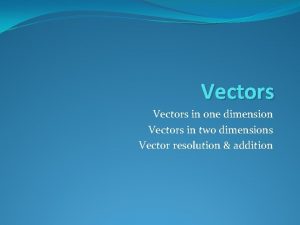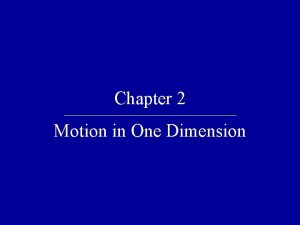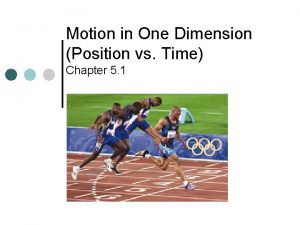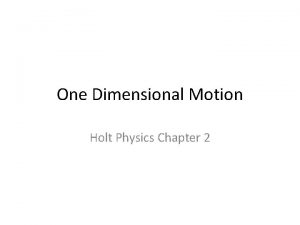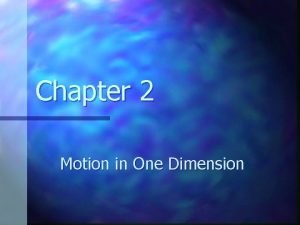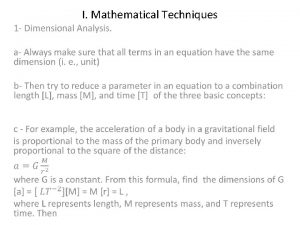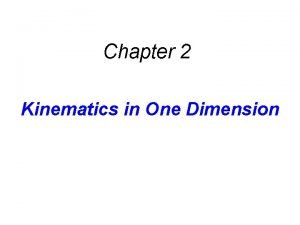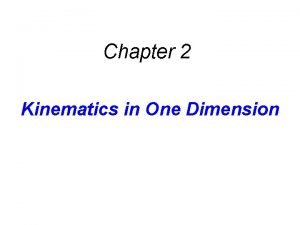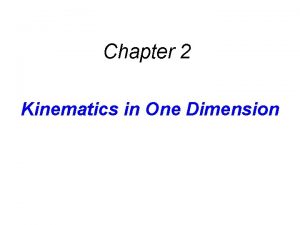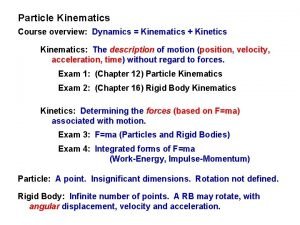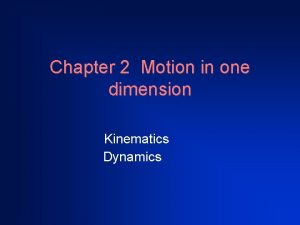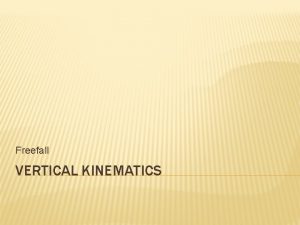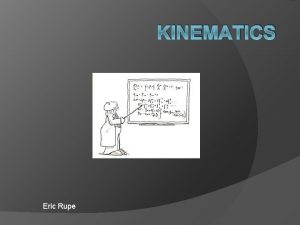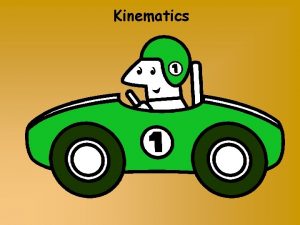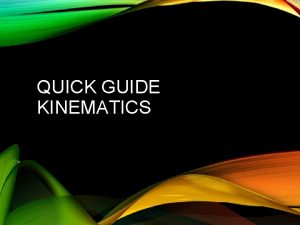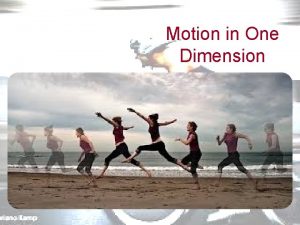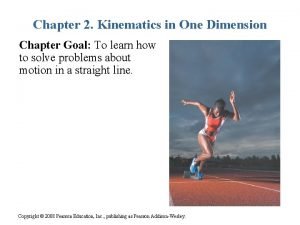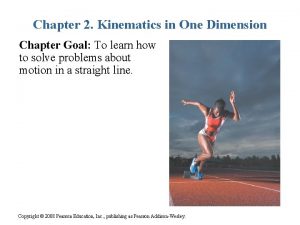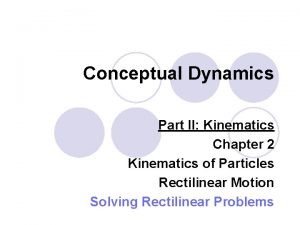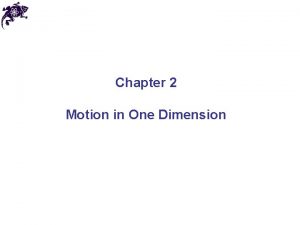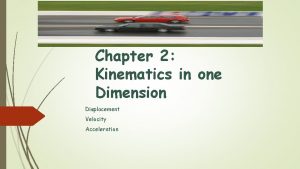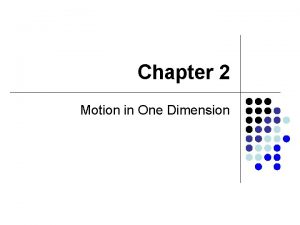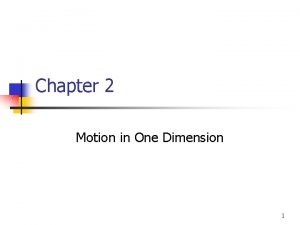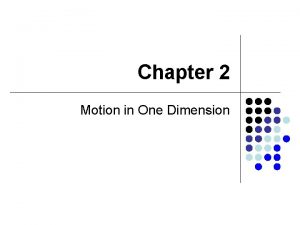Chapter 2 Kinematics in One Dimension Dynamics Dynamics























- Slides: 23

Chapter 2 Kinematics in One Dimension

Dynamics • Dynamics: branch of physics describing the motion of an object and the relationship between that motion and other physics concepts • Kinematics is a part of dynamics. In kinematics we are interested in the description of motion, without the description of the cause of the motion • Any motion involves three concepts used to study objects in motion: 1) Displacement 2) Velocity 3) Acceleration

Linear motion In this chapter we will consider moving objects: • Along a straight line • With every portion of an object moving in the same direction and at the same rate (particle-like motion)

Types of physical quantities • In physics, quantities can be divided into such general categories as scalars, vectors, matrices, etc. • Scalars – physical quantities that can be described by their value only • Vectors – physical quantities that can be described by their value (magnitude) and direction

Distance, position, and displacement • Distance (scalar) a total length of the path traveled regardless of direction (SI unit: m) • In each instance we choose an origin – a reference point, convenient for further calculations • Position of an object (vector) is described by the shortest distance from the origin and direction relative to the origin • Displacement (vector) – a change from position xi to position xf

Velocity and speed • Average speed (scalar) - a ratio of distance traveled (over a time interval) to that time interval (SI unit: m/s) • Average velocity (vector) - a ratio of displacement (over a time interval) to that time interval • Instantaneous velocity (vector) – velocity at a given instant • Instantaneous speed (scalar) – a magnitude of an instantaneous velocity

Velocity and speed

Velocity and speed

Instantaneous velocity • The instantaneous velocity is the slope of the line tangent to the x vs. t curve • This would be the green line • The light blue lines show that as Δt gets smaller, they approach the green line

Chapter 2 Problem 9 A tourist being chased by an angry bear is running in a straight line toward his car at a speed of 4. 0 m/s. The car is a distance d away. The bear is 26 m behind the tourist and running at 6. 0 m/s. The tourist reaches the car safely. What is the maximum possible value for d?

Acceleration • Average acceleration (vector) - a ratio of change of velocity (over a time interval) to that time interval (SI unit = (m/s)/s = m/s 2) • Instantaneous acceleration (vector) – a rate of change of velocity at a given instant

Acceleration • The blue line is the average acceleration • The slope (green line) of the velocity-time graph is the acceleration

Case of constant acceleration • Average and instantaneous accelerations are the same • Conventionally • Then

Case of constant acceleration

Case of constant acceleration • Average and instantaneous accelerations are the same • Conventionally • Then

Case of constant acceleration To help you solve problems Equations Missing variables

Case of constant acceleration

Case of constant acceleration

Graphical representation

Chapter 2 Problem 40 A Boeing 747 “Jumbo Jet” has a length of 59. 7 m. The runway on which the plane lands intersects another runway. The width of the intersection is 25. 0 m. The plane decelerates through the intersection at a rate of 5. 70 m/s 2 and clears it with a final speed of 45. 0 m/s. How much time is needed for the plane to clear the intersection?

Case of free-fall acceleration • At sea level of Earth’s mid-latitudes all objects fall (in vacuum) with constant (downward) acceleration of a = - g ≈ - 9. 8 m/s 2 ≈ - 32 ft/s 2 • Conventionally, free fall is along a vertical (upward) y-axis

Chapter 2 Problem 63 While standing on a bridge 15. 0 m above the ground, you drop a stone from rest. When the stone has fallen 3. 20 m, you throw a second stone straight down. What initial velocity must you give the second stone if they are both to reach the ground at the same instant? Take the downward direction to be the negative direction.

Questions?
 What is negative velocity on a graph
What is negative velocity on a graph Describing motion kinematics in one dimension
Describing motion kinematics in one dimension Describing motion kinematics in one dimension
Describing motion kinematics in one dimension Aplusphysics kinematics-horizontal kinematics
Aplusphysics kinematics-horizontal kinematics Kinematic equations
Kinematic equations A tourist being chased by an angry bear
A tourist being chased by an angry bear Rigid planar
Rigid planar Kinematics and dynamics of machines
Kinematics and dynamics of machines Forces in one dimension
Forces in one dimension Vf-vo
Vf-vo Chapter 4 forces in one dimension
Chapter 4 forces in one dimension One dimensional kinematics problems
One dimensional kinematics problems Chapter 12 kinematics of a particle solutions
Chapter 12 kinematics of a particle solutions Vectors in one dimension
Vectors in one dimension Motion in one dimension quiz
Motion in one dimension quiz To describe a position in more than one dimension
To describe a position in more than one dimension The sears tower in chicago is 443 m tall. suppose a book
The sears tower in chicago is 443 m tall. suppose a book Free fall motion in one dimension
Free fall motion in one dimension Undefined terms and basic definitions worksheet answers
Undefined terms and basic definitions worksheet answers Time dimension of research
Time dimension of research Motion in one dimension
Motion in one dimension Motion in one dimension
Motion in one dimension Motion in one dimension
Motion in one dimension One god one empire one religion
One god one empire one religion
